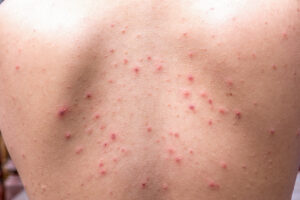
Article by Dr. Catherine Zip MD, FRCPC, FAAD
Body acne affects up to 50% of people with acne. Dr. Catherine Zip, a Calgary dermatologist and spokesperson for the Acne and Rosacea Society of Canada, helps us understand what body acne is, the causes and treatments.

As temperatures climb and we dig through our closets in search of tank tops and swimwear, we may be reminded of the red bumps on our chest and back – body acne. Although acne most commonly involves the face, in up to 50% of acne sufferers, it also involves the body.

Body acne, also dubbed “bacne”, is simply acne that is located on the body, including the chest, back, shoulders and, less commonly, the upper arms.
The development of body acne is felt to be the same as that of facial acne. Blocked oil glands in the skin, oil production, bacteria, hormones, genetics and inflammation all contribute to the development of acne.
As in the case of facial acne, the severity of body acne can range from very mild, with just a few red bumps on the chest and back, to severe, with deep tender cysts covering the chest and the entire back. Body acne can lead to darkening of the skin and scarring.
Many treatment options are available for treatment of body acne. Compared to facial acne, acne on the chest and back tends to be slower to respond to treatment so be patient!
Topical (applied to the skin) treatment can be used alone for mild acne or in combination with internal treatments (pills) for more severe acne.
Topical treatments commonly contain ingredients such as benzoyl peroxide, retinoids, and azaleic acid. They work by unblocking pores, reducing bacteria in the skin, and reducing inflammation. They can be difficult to apply on the back without help, and benzoyl peroxide can bleach fabrics that come into contact with treated skin, such as towels and bed linen.
Health Canada recently approved a new retinoid, Trifarotene, for body acne. It is one of a few drugs that has been clinically tested not only for effectiveness in moderate facial acne but also for moderate body acne on the back and chest.
Results of two Phase 3 clinical trials showed for moderate body acne on the back and chest, there was a 57.4% and 65.4% reduction in inflammatory acne (pus pimples and swollen, red bumps) and a 49.1 and 55.2% reduction in non-inflammatory acne (blackheads and whiteheads).
A number of internal medications, taken by mouth, can be prescribed to control bacne. Antibiotics such as doxycycline ,which reduce bacteria in the skin and also have anti-inflammatory properties, can be helpful. Use of combined oral contraceptives or spironolactone can improve acne in women by regulating hormones involved in acne.
For severe cases, isotretinoin can also be prescribed. It has many effects that improve acne, including unblocking pores and reducing oil production.
Over-the-counter treatments consist of medicated cleansers or washes and leave on products. These typically contain salicylic acid or benzoyl peroxide and can be helpful for mild acne on the chest and back. They can also be used in combination with prescription medications to improve response.
Little is known about what constitutes optimal skin care for the treatment of acne. It is reasonable to start with daily showering or bathing with use of a medicated cleanser containing salicylic acid or benzoyl peroxide. Leave the cleanser on for a few minutes before you rinse it off to allow it time to work. You can also opt for a leave on product containing salicylic acid or benzoyl peroxide, applying it after showering or bathing. When purchasing moisturizers or sunscreen to be used on the involved areas, chose products that are oil free and non-comedonic to avoid aggravating your acne with heavier products.
Massage oils can also trigger or aggravate acne particularly on the back.
Most people wonder if changing their diet will improve their acne. The short answer is that we don’t know for sure. However, there is some evidence that a high glycemic index diet, consisting of a high intake of sugars and refined carbohydrates, may aggravate acne. So you may want to try minimizing intake of sugars and replace refined carbohydrates with whole grain products to see if this helps your acne. Some people experience worsening of acne with use of whey protein supplements.
Whether sun exposure improves acne is controversial and should be avoided because it increases risk of skin cancer.
Body acne is common, affecting up to 50% of people with acne. If you have a mild case, start with over the counter cleansers or leave on products containing benzyol peroxide or salicylic acid. If you have more severe acne on your chest and back, or if you are developing acne scarring, make an appointment with your family doctor or dermatologist. Many effective prescription treatment options are available.
About the Author
Dr. Catherine Zip is a Calgary dermatologist and spokesperson for the Acne and Rosacea Society of Canada. She is a Clinical Associate Professor at the University of Calgary. Dr. Zip is in private practice at the Dermatology Centre in Calgary.
LEARN MORE
Test your acne knowledge. You may be surprised at some of the answers…